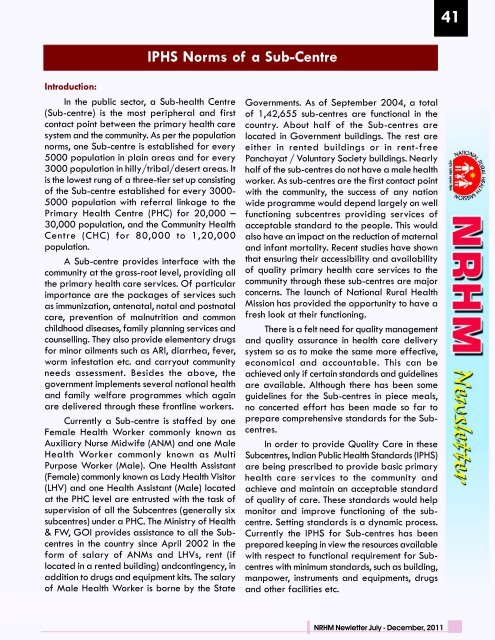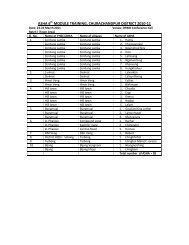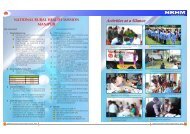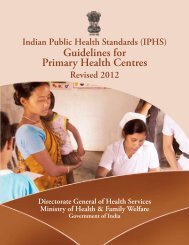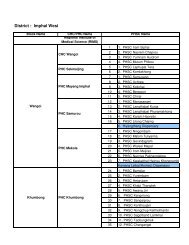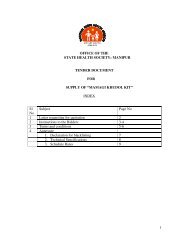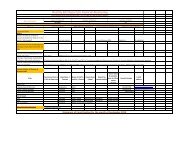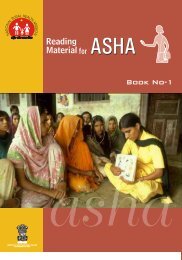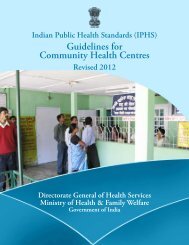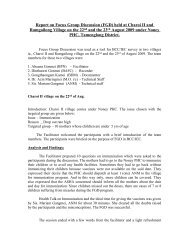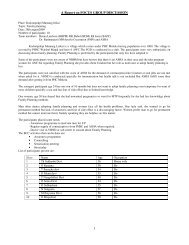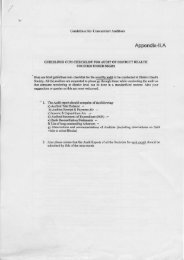cover file.cdr - NRHM Manipur
cover file.cdr - NRHM Manipur
cover file.cdr - NRHM Manipur
- No tags were found...
You also want an ePaper? Increase the reach of your titles
YUMPU automatically turns print PDFs into web optimized ePapers that Google loves.
41IPHS Norms of a Sub-CentreIntroduction:In the public sector, a Sub-health Centre(Sub-centre) is the most peripheral and firstcontact point between the primary health caresystem and the community. As per the populationnorms, one Sub-centre is established for every5000 population in plain areas and for every3000 population in hilly/tribal/desert areas. Itis the lowest rung of a three-tier set up consistingof the Sub-centre established for every 3000-5000 population with referral linkage to thePrimary Health Centre (PHC) for 20,000 –30,000 population, and the Community HealthCentre (CHC) for 80,000 to 1,20,000population.A Sub-centre provides interface with thecommunity at the grass-root level, providing allthe primary health care services. Of particularimportance are the packages of services suchas immunization, antenatal, natal and postnatalcare, prevention of malnutrition and commonchildhood diseases, family planning services andcounselling. They also provide elementary drugsfor minor ailments such as ARI, diarrhea, fever,worm infestation etc. and carryout communityneeds assessment. Besides the above, thegovernment implements several national healthand family welfare programmes which againare delivered through these frontline workers.Currently a Sub-centre is staffed by oneFemale Health Worker commonly known asAuxiliary Nurse Midwife (ANM) and one MaleHealth Worker commonly known as MultiPurpose Worker (Male). One Health Assistant(Female) commonly known as Lady Health Visitor(LHV) and one Health Assistant (Male) locatedat the PHC level are entrusted with the task ofsupervision of all the Subcentres (generally sixsubcentres) under a PHC. The Ministry of Health& FW, GOI provides assistance to all the Subcentresin the country since April 2002 in theform of salary of ANMs and LHVs, rent (iflocated in a rented building) andcontingency, inaddition to drugs and equipment kits. The salaryof Male Health Worker is borne by the StateGovernments. As of September 2004, a totalof 1,42,655 sub-centres are functional in thecountry. About half of the Sub-centres arelocated in Government buildings. The rest areeither in rented buildings or in rent-freePanchayat / Voluntary Society buildings. Nearlyhalf of the sub-centres do not have a male healthworker. As sub-centres are the first contact pointwith the community, the success of any nationwide programme would depend largely on wellfunctioning subcentres providing services ofacceptable standard to the people. This wouldalso have an impact on the reduction of maternaland infant mortality. Recent studies have shownthat ensuring their accessibility and availabilityof quality primary health care services to thecommunity through these sub-centres are majorconcerns. The launch of National Rural HealthMission has provided the opportunity to have afresh look at their functioning.There is a felt need for quality managementand quality assurance in health care deliverysystem so as to make the same more effective,economical and accountable. This can beachieved only if certain standards and guidelinesare available. Although there has been someguidelines for the Sub-centres in piece meals,no concerted effort has been made so far toprepare comprehensive standards for the Subcentres.In order to provide Quality Care in theseSubcentres, Indian Public Health Standards (IPHS)are being prescribed to provide basic primaryhealth care services to the community andachieve and maintain an acceptable standardof quality of care. These standards would helpmonitor and improve functioning of the subcentre.Setting standards is a dynamic process.Currently the IPHS for Sub-centres has beenprepared keeping in view the resources availablewith respect to functional requirement for Subcentreswith minimum standards, such as building,manpower, instruments and equipments, drugsand other facilities etc.<strong>NRHM</strong> Newletter July - December, 2011


